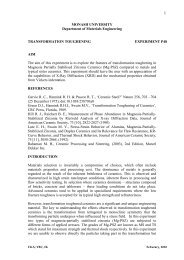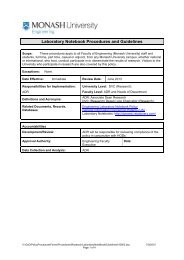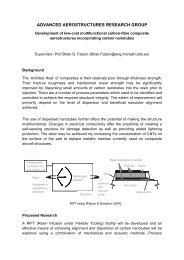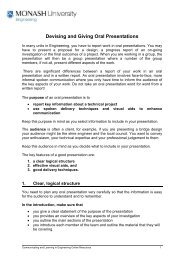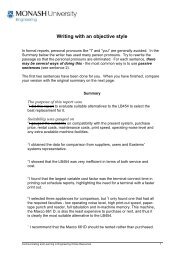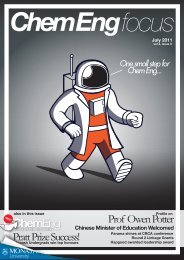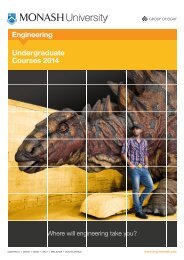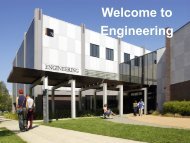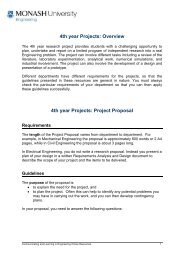Biomaterials - Faculty of Engineering - Monash University
Biomaterials - Faculty of Engineering - Monash University
Biomaterials - Faculty of Engineering - Monash University
Create successful ePaper yourself
Turn your PDF publications into a flip-book with our unique Google optimized e-Paper software.
<strong>Biomaterials</strong><br />
Department <strong>of</strong> Materials <strong>Engineering</strong><br />
www.eng.monash.edu
<strong>Biomaterials</strong><br />
The intersection <strong>of</strong> biomedical science and materials engineering is an exciting one,<br />
and largely falls in the province <strong>of</strong> biomaterials and tissue engineering. Many <strong>of</strong> the<br />
advances being made at the interface <strong>of</strong> these two disciplines are central to new medical<br />
and health-based technologies and are changing the way we live and treat illness.<br />
<strong>Monash</strong> <strong>University</strong> is a leader in many aspects <strong>of</strong> biomedical engineering and<br />
exciting opportunities exist within Materials <strong>Engineering</strong> in the area <strong>of</strong> biomaterials<br />
and tissue engineering. Australia has an urgent need for biomedical engineers<br />
with a solid grounding in biomedical science and materials engineering.<br />
<strong>Biomaterials</strong> are materials that are used in medical devices or are in contact with biological<br />
systems and do not adversely affect the living organism. The field <strong>of</strong> biomaterials is highly<br />
multidisciplinary and involves principles from medicine, materials science and engineering,<br />
chemistry and biology. It involves the engineering and testing <strong>of</strong> materials for use in<br />
devices for therapies. Its multidisciplinary nature <strong>of</strong>ten means that materials engineers<br />
work closely with surgeons, microbiologists, ethicists, and lawyers to name a few.<br />
Applications include:<br />
• implants eg. titanium hip<br />
joints, artificial lenses<br />
• tissue engineering for the regeneration <strong>of</strong><br />
damaged or diseased tissues eg. nerve<br />
regeneration for spinal cord injuries<br />
• ‘smart’ surfaces for the culture<br />
<strong>of</strong> embryonic stem cells<br />
• artificial muscles using<br />
electroactive polymers<br />
• using peptides and DNA<br />
molecules as building blocks to<br />
build new nano-structures<br />
• ‘bionanotech’ engineering approaches<br />
to manipulate cell function<br />
• site specific drug delivery using<br />
nano-structured materials<br />
• improved dressings for chronic wounds<br />
How important are<br />
biomaterials<br />
Commercially, biomaterials are <strong>of</strong> enormous<br />
importance. It is thought that biomaterialsbased<br />
devices cost some $AUS400 billion<br />
dollars per year which constitutes roughly 8%<br />
<strong>of</strong> money spent on health-related issues (1).<br />
Even a specialist business such as making<br />
spinal implants is currently a $2.5 billion<br />
industry today but is expected to involve<br />
some $25 billion in sales for this orthopaedic<br />
device alone in future years. (2)<br />
The wound repair market in the US, for<br />
example, is currently $520 million, heading<br />
up to $900 million in a matter <strong>of</strong> years. (3)<br />
One <strong>of</strong> the most widely used biomaterialsbased<br />
prosthetics is the hip replacement<br />
and it is estimated that 1,000,000 <strong>of</strong> these<br />
are implanted per year worldwide. (4)<br />
Opportunities and careers<br />
The use <strong>of</strong> materials in biomaterials<br />
applications gives them enormous value,<br />
compared to being used in other applications.<br />
For example, its been estimated that<br />
$600,000 worth <strong>of</strong> materials used<br />
traditionally in non-bio areas, has<br />
the value <strong>of</strong> some $10.5 billion when<br />
constructed into biomedical devices. (5)<br />
This helps explain why there is so much<br />
commercial interest in biomaterials.<br />
Potential jobs at the intersection<br />
<strong>of</strong> biomedical science and<br />
materials engineering<br />
Tissue engineering – is the application<br />
<strong>of</strong> engineering and biological principles<br />
to assist regeneration <strong>of</strong> lost or<br />
damaged tissues or organs.<br />
Underpinning tissue engineering are<br />
scaffolds, which are three-dimensional<br />
engineered materials that provide the<br />
foundation for cell growth and function.<br />
After the scaffold has served its<br />
purpose it degrades away – similar<br />
to the temporary scaffolding for the<br />
repair or construction <strong>of</strong> buildings.<br />
There is an urgent demand for materials<br />
engineers to design and fabricate artificial<br />
scaffolds which are load bearing, control<br />
cell function and promote the growth <strong>of</strong> new<br />
blood vessels deep inside the construct.<br />
Scaffolds are currently being engineered to<br />
allow nerves to regrow for the repair <strong>of</strong> spinal<br />
cord injuries or to repair large bone defects.<br />
Neural tissue engineering <strong>of</strong> the brain<br />
is a particular strength within the<br />
Department <strong>of</strong> Materials <strong>Engineering</strong>.<br />
Hip implant using ‘smart’ materials to improve<br />
integration into the body.<br />
Prosthetic devices – hip, knee, elbow<br />
implants. These must be made <strong>of</strong><br />
combinations <strong>of</strong> materials, which are<br />
strong, hard, abrasion resistant, corrosion<br />
resistant, biocompatible and have low<br />
friction. They also must be surface<br />
modified to reduce inflammation and host<br />
rejection when implanted in the body.<br />
Titanium hip implants are <strong>of</strong>ten coated<br />
with ceramics that mimic natural<br />
bone to improve integration.<br />
Drug delivery – Traditionally drugs are<br />
delivered orally or intravenously, however<br />
this approach targets all tissues, both healthy<br />
and ill without discrimination. Degradable<br />
polymeric delivery systems are being<br />
investigated to release drugs at a specific site<br />
in the body eg. at the site <strong>of</strong> a hip implant.<br />
Site-specific application <strong>of</strong> drugs dramatically<br />
reduces drug concentration in the body,<br />
limiting undesirable side effects and<br />
increasing drug potency. In addition,<br />
many new drugs have poor solubility in<br />
the body rendering them ineffective.<br />
Encapsulation <strong>of</strong> drugs within polymeric<br />
nano-scale particles is being investigated<br />
as a means to overcome these problems<br />
and is being used for new treatments <strong>of</strong><br />
neurological disorders and to target tumours.
New materials for control <strong>of</strong> stem cell<br />
behaviour – A major issue with the use<br />
<strong>of</strong> stem cells is their limited number for<br />
therapeutic applications and the difficulty in<br />
controlling the differentiation <strong>of</strong> these cells.<br />
A major research initiative is the design<br />
and fabrication <strong>of</strong> three-dimensional<br />
artificial niches to increase the proliferation<br />
<strong>of</strong> stem cells and to control the<br />
differentiation status <strong>of</strong> these cells.<br />
Gene therapy – involves the insertion<br />
<strong>of</strong> genes into cells for the treatment <strong>of</strong><br />
diseases. Genes are generally delivered<br />
using viruses however there are associated<br />
problems with host immune reactions.<br />
Synthetic polymeric nanoparticles<br />
that self assemble are actively being<br />
investigated as alternatives to viruses.<br />
Surface treatment <strong>of</strong> materials –<br />
It is <strong>of</strong>ten financially restrictive for<br />
biomedical companies to synthesize<br />
new materials from scratch.<br />
However, existing biomaterials are <strong>of</strong>ten<br />
surface modified to dramatically improve<br />
their interaction with the body. For instance,<br />
many contact lenses are modified by<br />
depositing nano-sized polymeric films on the<br />
surface to improve the wettability <strong>of</strong> the lens,<br />
making them more comfortable to wear.<br />
New ‘protein repellent’ surfaces –<br />
The performance <strong>of</strong> many biomedical<br />
devices such as biosensors are highly<br />
dependent on the surface resisting the<br />
build up <strong>of</strong> proteins found naturally in the<br />
body – these surfaces are commonly called<br />
‘low fouling’. New polymeric materials are<br />
being engineered to resist the adherence<br />
<strong>of</strong> proteins and to gain a fundamental<br />
understanding <strong>of</strong> protein-surface interactions.<br />
Biomimetic materials – The construction<br />
<strong>of</strong> artificial materials that mimic natural<br />
forms. Common examples are nanorough<br />
surfaces (dirt falls <strong>of</strong>f, lotus leaf<br />
effect) or materials, which try to emulate<br />
the toughness <strong>of</strong> nanocomposite abalone<br />
shell or the extraordinary adhesive<br />
(and self-cleaning) properties <strong>of</strong> the<br />
gecko pad (millions <strong>of</strong> tiny hairs).<br />
SEM <strong>of</strong> an experimental flame sprayed coating for<br />
surface treatment <strong>of</strong> titanium implants.<br />
What type <strong>of</strong> area is<br />
important in biomaterials<br />
Successful biomaterials work requires<br />
scientists to have knowledge <strong>of</strong> a wide<br />
range <strong>of</strong> areas: toxicology, biocompatibility,<br />
healing, mechanical and performance<br />
requirements, industrial expertise,<br />
ethics and regulations expertise. (8)<br />
These are the sorts <strong>of</strong> areas that would<br />
be studied in a biomedical science/<br />
engineering (with specialisation in<br />
Materials <strong>Engineering</strong>) degree.<br />
What sort <strong>of</strong> jobs<br />
would they do<br />
As for other materials scientists and<br />
engineers, materials engineers with training<br />
in the biomedical science area would<br />
work in the development <strong>of</strong> new materials<br />
and products, as well as in sales and<br />
marketing, technical services, management,<br />
quality control, process control, and as<br />
consultants. They would also be well placed<br />
to undertake research into biomaterials.<br />
What is the state <strong>of</strong> the<br />
biomaterials-related<br />
industries in Australia now<br />
<strong>Biomaterials</strong> are clearly a booming<br />
area <strong>of</strong> high commercial activity, with<br />
an expanding industrial base. This is<br />
as true in Australia as anywhere else,<br />
and is well recognised by the Australian<br />
Government which notes that Australia<br />
has a reputation for leading advances in<br />
biotechnology and biomaterials, particularly<br />
in “biomaterials for medical uses such as<br />
surgically-implanted devices or scaffolds<br />
(4) and targeted drug delivery”. (6) (7)<br />
Many <strong>of</strong> the biomedical companies, for<br />
example on the Australian Biotechnology<br />
Organisation corporate register, require<br />
scientists who have an understanding<br />
and ability to manipulate materials<br />
properties related to biotechnology,<br />
generally to develop devices. (8)<br />
Examples <strong>of</strong> the type <strong>of</strong> companies<br />
in Australia that would employ<br />
<strong>Biomaterials</strong> Engineers are:<br />
Aortech: artificial heart valves<br />
PolyNovo: biodegradable materials for<br />
medical devices and tissue engineering<br />
Cochlear Lt: bionic ear<br />
Ciba Vision: contact lenses<br />
CSIRO: contact lenses, heart<br />
valves, tissue engineering<br />
ASCC: smart polymers for<br />
maintenance <strong>of</strong> stem cells<br />
Biota: biomaterials for drug delivery<br />
BresaGen: scaffolds for treatments<br />
<strong>of</strong> Parkinson’s disease<br />
Chiron: polymers for peptide synthesis<br />
CSL: polymers for drug delivery<br />
All major hospitals: (prosthesis<br />
development)<br />
Patent attorneys: dramatic<br />
increase in patents in this area<br />
Future directions<br />
It has been said that “The most important<br />
advance in the 21st century will be the<br />
introduction <strong>of</strong> atomic-scale prostheses to<br />
repair and restore human body function...<br />
the fusion <strong>of</strong> atomic-scale engineering<br />
technology with our bodies will enormously<br />
enhance human performance”. (9)<br />
The fusion <strong>of</strong> nanomaterials engineering<br />
(which deals with the manipulation <strong>of</strong><br />
ten’s <strong>of</strong> atoms, and thus works at the<br />
10 -9 m size-scale) and biotechnology<br />
will allow unprecedented scope for<br />
materials scientists and engineers to<br />
tackle diseases and medical problems<br />
in a smarter and more targeted manner.<br />
The Department <strong>of</strong> Materials <strong>Engineering</strong><br />
aims to teach the necessary skills<br />
in its undergraduate and research<br />
programs, <strong>of</strong>fering specific subjects<br />
dealing with biomaterials.<br />
What are your options<br />
Bachelor <strong>of</strong> Biomedical<br />
Science/Bachelor <strong>of</strong><br />
<strong>Engineering</strong> (Specialising in<br />
Materials <strong>Engineering</strong>)<br />
This is an exciting new double-degree<br />
program, allowing the choice <strong>of</strong> subjects<br />
from the faculty <strong>of</strong> medicine in the<br />
field <strong>of</strong> biomedical science and those<br />
<strong>of</strong> materials engineering, leading to a<br />
unique and highly useful combination.<br />
Bachelor <strong>of</strong> Science/Bachelor<br />
<strong>of</strong> <strong>Engineering</strong> (Specialising<br />
in Materials <strong>Engineering</strong>)<br />
It is possible to do a combined engineering/<br />
science degree where the science<br />
physiology major is combined with a full<br />
materials engineering degree. An alternative<br />
is to choose any two science majors in<br />
combination with a Bachelor <strong>of</strong> <strong>Engineering</strong><br />
specialising in materials engineering.<br />
Benefits <strong>of</strong> undertaking<br />
a combined degree<br />
• Obtain two fully-recognised degrees<br />
in materials engineering and<br />
biomedical science in five years<br />
• Obtain the multi-disciplinary skills essential<br />
within leading biotech industries<br />
• Be at the forefront <strong>of</strong> leading biomedical<br />
engineering research and applications<br />
• Obtain versatility in gaining employment<br />
as either a materials engineer or<br />
biomedical scientist, or in the fascinating<br />
interface between the two fields.
Some examples <strong>of</strong> our biomaterials research projects<br />
Embryonic stem cells-derived<br />
cardiomyocytes<br />
Neural stem cells attaching to a<br />
modified electrospun scaffold.<br />
Partially aligned polymer nan<strong>of</strong>ibres, and neurons growing along the direction<br />
<strong>of</strong> the nan<strong>of</strong>ibres.<br />
<strong>Engineering</strong> smart<br />
nanomaterials to<br />
repair damaged neural<br />
pathways in the central<br />
nervous system<br />
Neural tissue engineering (NTE) is a<br />
method <strong>of</strong> regeneration <strong>of</strong> damaged<br />
neurons providing cellular niches,<br />
which promote attachment, growth,<br />
proliferation and migration.<br />
Electrospun scaffolds are ideal for NTE,<br />
as nano-scale architectures can be<br />
fabricated that have dimensional similarities<br />
to the native basement membrane.<br />
Neural stem cells’ differentiation is dependant<br />
on the physical and chemical properties<br />
<strong>of</strong> the scaffold. The physical environment<br />
provides cues that can be exploited<br />
to enhance and direct differentiation.<br />
Furthermore, electrospun scaffolds can be<br />
easily functionalised to promote adherence.<br />
The longer-term goal <strong>of</strong> this research<br />
is to utilise cell-scaffold constructs<br />
that will assist in functional recovery <strong>of</strong><br />
the damaged spinal cord in vivo.<br />
Biocompatible<br />
power sources<br />
Biocompatible power sources are the<br />
key to many implantable biomedical<br />
devices including pacemakers,<br />
cochlear ear implants and sensors.<br />
Recently some exciting work in the field <strong>of</strong><br />
magnesium biocompatible batteries has<br />
evolved. This battery will be used to stimulate<br />
nerve regeneration by controlling the release<br />
<strong>of</strong> growth hormones from conducting<br />
polymers; this work is in collaboration with<br />
Pr<strong>of</strong>essors Gordon Wallace and Graeme<br />
Clarke who head up the Bionics program<br />
within the Centre for Electromagnetic<br />
Materials. This program is ultimately aimed<br />
at nerve regeneration for spinal cord repair.<br />
The battery itself is comprised <strong>of</strong> a Mg<br />
or Mg alloy anode, a cathode and a<br />
biocompatible ionic liquid-based electrolyte.<br />
Research is aimed at understanding the<br />
interfacial behaviour in the battery as well<br />
as the influence <strong>of</strong> material morphology<br />
and composition for each <strong>of</strong> the key<br />
components (ie. anode, electrolyte and<br />
cathode) in achieving sufficient current<br />
densities. Possible methods <strong>of</strong> encapsulation<br />
in an oxygen permeable, biocompatible<br />
polymer are also being investigated.<br />
New materials for implants<br />
Heart disease is the leading cause <strong>of</strong> death<br />
and disability worldwide, accounting for<br />
30–40 per cent <strong>of</strong> all human mortality.<br />
Currently two strategies, (embryonic) stem<br />
cell-based therapy and left ventricle restraint<br />
are under intensive investigation for the<br />
treatment <strong>of</strong> the devastating disease.<br />
A combinatorial approach <strong>of</strong> stem cell<br />
therapy and mechanical passive restraint<br />
represents a novel approach. A heart<br />
patch serves two purposes: to deliver<br />
functional cardiomyocytes to the infarct<br />
heart muscle and provide mechanical<br />
restrain to the weak left ventricle.<br />
The essential requirements on a heart<br />
patch material include long-term elasticity,<br />
cell-delivery ability and degradability.<br />
The most important challenge that materials<br />
scientist currently encounter in the field<br />
<strong>of</strong> cardiac tissue engineering is to make a<br />
nonlinear elastic polymer that is similar to<br />
that <strong>of</strong> the myocardium. Such nonlinear<br />
elasticity would ensure that the heart patch<br />
can ‘beat’ together with the recipient heart,<br />
thus providing appropriate restraints to the<br />
left ventricle throughout the beating process.<br />
New biocompatible rubbers, including<br />
crosslinked and thermoplastic elastomers,<br />
are under development in our research.<br />
Other work involves the development<br />
<strong>of</strong> materials, which would be<br />
suitable for temporary implants.<br />
The need for such materials is particularly<br />
great in vascular surgery where a temporary,<br />
bioresorbable stent could provide support to<br />
the walls <strong>of</strong> a blood vessel when it is required<br />
and dissolve when its mission is fulfilled –<br />
without a further invasion <strong>of</strong> the surgeon.<br />
Tough requirements on such materials with<br />
regard to their strength, fatigue resistance<br />
and biocorrosion properties are being<br />
addressed by developing processing<br />
techniques that help in establishing the<br />
desired combinations <strong>of</strong> properties.<br />
Work in this area requires cross-disciplinary<br />
collaboration between materials engineers,<br />
biologists and clinical doctors and<br />
<strong>of</strong>fers exciting research opportunities for<br />
undergraduate and graduate students.<br />
Enquiries<br />
Dr John Forsythe<br />
Department <strong>of</strong> Materials <strong>Engineering</strong> <strong>Monash</strong><br />
<strong>University</strong> Vic 3800<br />
Tel: +61 3 9905 9609<br />
Fax: +61 3 9905 4940<br />
Email: john.forsythe@eng.monash.edu.au<br />
Web: www.eng.monash.edu/materials<br />
(1) Lysaght, M J, O’Laughlin, J.<br />
The demographic scope and economic<br />
magnitude <strong>of</strong> contemporary organ replacement<br />
therapies. ASAIO 2000; J46: 515-21.<br />
(2) www.onemedplace.com<br />
(3) www.the-infoshop.com/study/mrg31351-<br />
wound-management.html<br />
(4) www.uweb.engr.washington.edu/<br />
research/tutorials/Introbiomat.html<br />
(5) www.bizjournals.com/sanjose/<br />
stories/1998/05/11/editorial7.html<br />
(6) www.austrade.com/Biotechnology<br />
(7) www.investaustralia.gov.au<br />
(8) www.ausbiotech.org<br />
(9) William A. Hazeltine,<br />
CEO <strong>of</strong> Human Genome Sciences in<br />
“The Next Pharmaceutical Century”, C & EN<br />
CRICOS provider: <strong>Monash</strong> <strong>University</strong> 00008C.<br />
Disclaimer: While the information provided in this flyer was correct at the time <strong>of</strong> its publication, <strong>Monash</strong> <strong>University</strong> reserves the right to alter procedures, fees and regulations<br />
should the need arise. Students should carefully read all <strong>of</strong>ficial correspondence, and other sources <strong>of</strong> information for students (such as websites and <strong>of</strong>ficial university noticeboards)<br />
to be aware <strong>of</strong> changes to the information contained in this document and alterations to units. The information published was correct as at February 2009.




